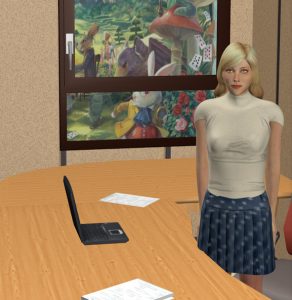Vahl Detect
The application "Vahl Detect" uses ARIA-VALUSPA to build an access controll system with face recognition and liveness detection. The work, which is presented in the video below, was done by a student group of the University of Nottingham.
The virtual journalist
The use of virtual humans is consequently becoming increasingly popular in a wide range of areas where such
a natural communication might be beneficial, including entertainment, education, mental health research and beyond. Behind this development lies a series of technological advances in a multitude of disciplines, most notably natural language processing, computer vision,
and speech synthesis.
The project "Virtual Human Journalist" employs a number of novel solutions from these disciplines with the goal to demonstrate their viability by producing a humanoid conversational agent capable of naturally eliciting and reacting to information from a human user. A set of qualitative and quantitative evaluation sessions demonstrated the technical feasibility of the system whilst uncovering a number of deficits in its capacity to engage users in a way that would be perceived as natural and emotionally engaging. "The Virtual Journalist" started on the last years the eNTERFACE'16, at the University of Twente. It uses the latest Virtual Human technology developed in the ARIA-VALUSPA EU project.
Adapting a Robot's linguistic style based on socially-aware reinforcement learning.
The core of the Aria platform (SSI recognition pipeline including Emax, Opensmile, Cerevoice) is used on a social robot to replicate the Aria scenario (Alice in Wonderland). In addition, the demo features reinforcement learning and natural language generation to adapt the robot's linguistic style to the user's personality preferences. For more details see: Hannes Ritschel, Tobias Baur, Elisabeth André: Adapting a Robot's linguistic style based on socially-aware reinforcement learning. RO-MAN 2017: 378-384.
